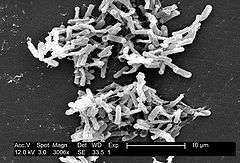Clostridioides
| Clostridioides | |
|---|---|
 | |
| SE micrograph of Clostridium difficile colonies from a stool sample | |
| Scientific classification | |
| Domain: | Bacteria |
| Phylum: | Firmicutes |
| Class: | Clostridia |
| Order: | Clostridiales |
| Family: | Clostridiaceae |
| Genus: | Clostridioides Lawson (microbiologist) and Rainey (biologist) (2016) |
| Selected species | |
| |
Clostridioides is a genus of Gram-positive bacteria, which includes Clostridioides difficile, a human pathogen causing an infectious diarrhea.
Taxonomy
The Clostridioides genus name was created in order to separate species formerly in the Clostridium genus which have been shown to be genetically far removed from that group using 16S rRNA gene sequence analysis.[1]
Description
They are obligate anaerobes capable of producing endospores. The normal, reproducing cells of Clostridioides, called the vegetative form, are rod-shaped, which gives them their name, from the Greek κλωστήρ or spindle. Clostridioides endospores, like Clostridium endospores, have a distinct bowling pin or bottle shape, distinguishing them from other bacterial endospores, which are usually ovoid in shape.
References
- ↑ Lawson, Paul A; DM Citron; KL Tyrrell; SM Finegold (August 2016). "Reclassification of Clostridium difficile as Clostridioides difficile". Anaerobe. 40: 95–99.